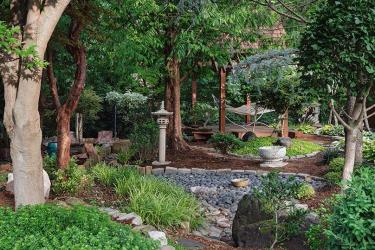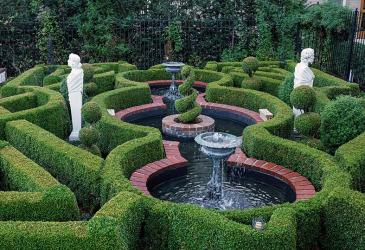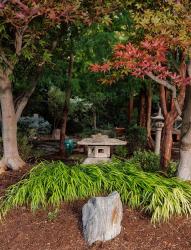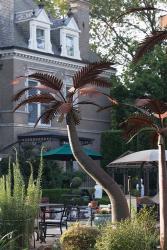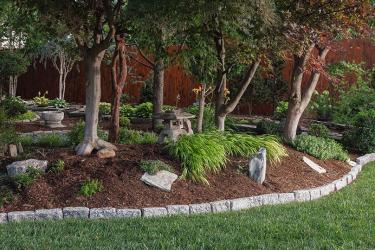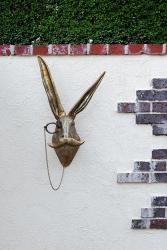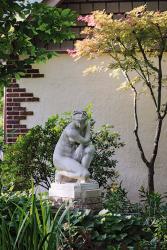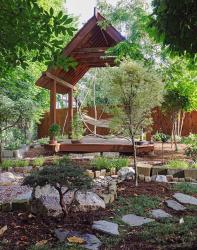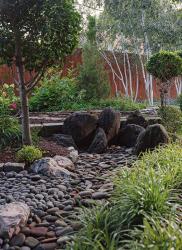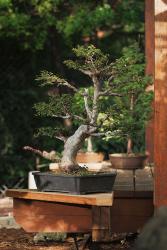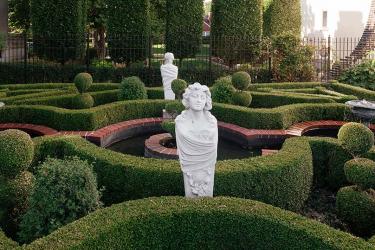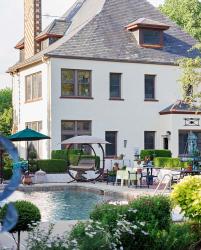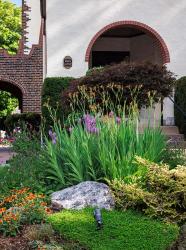“A journey of 1,000 miles begins with a single step.”
That ancient Chinese proverb makes perfect sense to John Merkle. Physically, his gardening journey, covering 32 years, is locked into his one-acre yard in Compton Heights, southwest of downtown St. Louis. But those who walked the space on the recent Missouri Botanical Garden Garden Tour traveled thousands of miles around the world. They experienced the intricate, geometric beauty of 400 Green Velvet boxwoods artfully designed into an English knot garden; the simplistic and symbolic lines of a Japanese landscape, complete with a tea house platform and dry stream bed; the architectural joy of perfectly pruned birches reminiscent of Colorado or even Russia; the vertical accents of wave-carved, pillar-like Taihu stones from a Chinese lake, and wrought-iron decor from the Paris flea market transformed in poolside tables and wall art.
While a worldwide travel snapshot for garden visitors, John has undoubtedly walked more than 1,000 actual miles around his property in the more than three decades it has taken to create his global gardening masterpiece. The pathways and patio alone, composed of 4,000 bricks, had to be taken wheelbarrow full by wheelbarrow full, from the street to the back yard, when the truck delivering them proved too large to go under the brick porte cochere covering the driveway at the side of the house. The garden’s design and the majority of the digging, pruning and planting is John’s alone with an assist from weekend and afterhours handymen when a task was too big for one person or required skills he felt better left to others. “I can be a good second assistant or a pack mule hauling things up from the street,” he says with a laugh.
John, who grew up in Godfrey, IL, on an acre and a half property, has his own set of skills. “My Dad was a gardener and spent a lot of time outdoors,” he recalls. “As a kid I had a little vegetable garden. I always knew when I had some property, I would have a garden.” Now, a retired radiologist, he trained and worked in Houston and California before becoming “homesick” for the Midwest and returning to St. Louis. He feels his background in using medical imaging to diagnose and treat disease has been a plus in being able to visualize the design of his garden. “Radiology is overwhelmingly visual,” he explains. “You have to look at images with your eyes and make decisions based on those images. It’s one of the things I do best.”
When he was still in his 20s and in training, John began collecting pictures of what he someday wanted his house and garden to look like. “I read Architectural Digest, Veranda and Gardens Illustrated. I knew someday I would have a house and yard,” he explains. “I’d take the magazines apart and save pages and articles. I ended up with six or seven binders of things I would like to recreate.” He traveled extensively and when he did, he visited botanical gardens in the United States and abroad. Once he bought his house in St. Louis, “I would jog to the Missouri Botanical Garden.”
John first saw his historic, French chateau-style home while he was on a Compton Heights house tour in 1991 and noticed a “for sale” sign in front of a nearby residence. “The house was so unique, I thought, ‘If it is anything on the inside like it is on the outside, I might have something here.’” For the first couple of years he owned the house, he spent his time and money doing the “invasive and messy” things such as installing central air conditioning and refinishing the floors.
The main feature of the back yard was a swimming pool dating back to the 1970s. Rather than adding landscaping around the pool, which he planned to eventually replace, John took his first gardening “step” along the back perimeter of the property, planting bamboo in an area, which was choked with weeds, brush and a decrepit chain link fence
“I did a bed a year and worked my way around the property,” he explains. His eye for design guided most of the work. He spaded alongside his handymen assistants, many of whom came from Perryville, where John had a hospital affiliation. “I was able to tell them where to start and stop on each project,” he explains. He called on his brother-in-law for help in creating the Japanese-style dry stream bed.
His instincts alone were not good enough when it came to replacing the old pool with a new sa ltwater pool and creating a new patio. That became a two-year effort. A 40-foot telephone pole had loomed beside the old pool. That, John knew, had to go. Working with John’s ideas, a friend in Chicago created an architectural blueprint that included the pool and multilevel patio and called for burying electrical and gas lines, while providing ample surface electrical outlets for future lighting requirements.
As his garden took shape, John’s love of history, art and architecture became apparent in the ways he creatively adorned the landscape with objects other than plants. Classical herms, Carrera marble statues with Greek heads and pillar-like bodies (often used to mark ancient crossroads) and metallic, patina-accented fountains highlight the knot garden. A palm tree made from old airline parts with rounded yard lights resembling coconuts stands poolside. Stone snow lanterns, urns and sculptural bonsai set the mood in the Japanese garden. A Carrera marble crouching Venus rises above a garden bed. And black wire garden obelisks, created from old coat hangers provide, height amidst low-growing plants. Almost all the garden accents were sourced locally, John says proudly.
To find interesting and unusual plants, he scours local nurseries, most of whom know him by sight and name. Timberwinds in Ellisville and Sugar Creek in Kirkwood are two favorites. The mini-mondo grass throughout the Japanese area of his garden, he discovered at Rolling Ridge in Webster Groves. When he finds plants he likes, “I haul them home, unless they are too big to fit into my Jeep. “I like to push the envelope,” he says. “I look for things that do well in this climate. Part of my yard gets sun all day and can get very hot. I look for plants from South Africa and Asia that are in the same latitude. This is really a specimen garden; a plant collector’s garden.”
Even with careful selection, he estimates that 5 percent of what he puts into the ground “will never make it. You can plant two of the same thing 15 feet apart and one will thrive and the other will die. There is always something that has to be replaced.” One of the first things he planted, the bamboo, grew too well, overwhelming the back of the yard. After several years he replaced it with a line of ‘Royal Frost’ birches and specimen evergreens. As a comical nod to the rabbits who regularly banquet on the perennials in his yard, a bronze aluminum wall hanging of Eric the Hare, from the beloved children’s story Eric and Eloise, decorates a stucco wall by the back door. It “leapt” into his Jeep at Garden Heights Nursery in Richmond Heights.
What he loves about gardening is “the process. It keeps me off the streets,” John explains with a laugh. “I don’t mind being on my hands and knees and getting dirty. If I’d had all this done by a landscaping company, the cost would have been prohibitive.”
Yardwork also is therapeutic, he believes. “I can get a lot of thinking done while I garden. I’ve made major decisions like switching groups in my medical practice while gardening. It is a physical process with an end result. If something is a little overgrown, I can work on it for a half hour, and it goes from ragged to beautiful. It can be hard work. If you don’t have a passion for it, I don’t recommend it,” he continues. But “if you are a gardener, you don’t need a therapist. If you are not in a good mood, go outside and work 10 minutes in the garden and you’ll be reset.”


